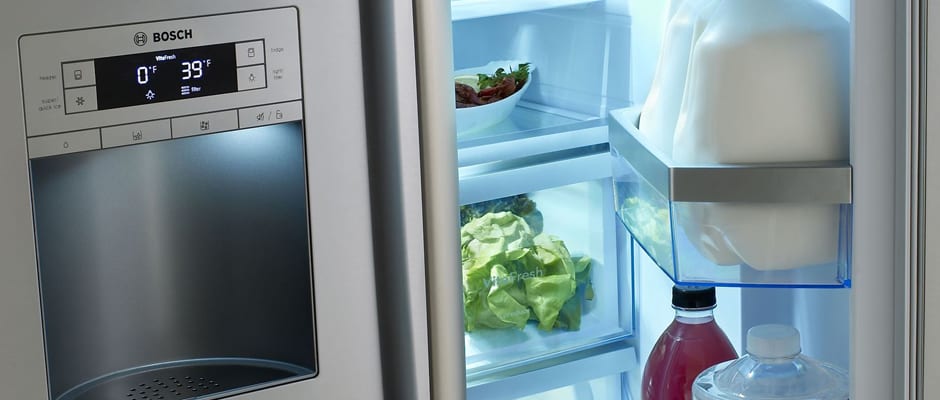Introduction
Design & Usability
{{section_header}}{{section.name}}{{/section_header}}
This Bosch fridge looks elegant and stylish. It also has the manufacturer’s name printed all over it in case you forget.
The fact that this particular model isn’t of gargantuan proportions is what saves it from looking too boxy. The smooth, stainless finish looks very sleek despite the prominent grain, which is only visible when hit by the light at certain angles. In regards to smudging, it doesn't help that this grain is only sometimes visible.
The Bosch’s interior is very typical of a French door layout. There are very few surprises in either compartment, though the LED lighting is a nice touch. While the layout should be very familiar to consumers, it's worth mentioning that the wide drawer in the fridge doesn't get its own thermostat; it's basically a big deli bin.
The only unusual thing worth mentioning about the freezer is the built-in handle found on the divider in the main storage bucket. You can actually lift this compartment up and out of the freezer, something that could come in handy for cleaning. Again, you may notice that Bosch put the company name on at least one surface in every cavity, door, nook, and cranny of this fridge… just in case you want to be reminded who built the product you bought.
{{photo_gallery "Front Photo", "Fingerprints Photo", "Handle Photo", "Handle Detail Photo", "Water/Ice Dispenser Photo", "Water/Ice Dispenser Controls Photo", "Water/Ice Dispenser Detail Photo", "Interior Photo", "Refrigerator Main 1 Image", "Refrigerator Main 2 Image", "Refrigerator Main 3 Image", "Water Filter Photo", "Refrigerator Door 1-1 Image", "Refrigerator Door 1-2 Image", "Refrigerator Door 1-3 Image", "Refrigerator Door 2-1 Image", "Refrigerator Door 2-2 Image", "Refrigerator Door 2-3 Image", "Freezer Main 1 Image", "Freezer Main 2 Image", "Freezer Main 3 Image", "Freezer Door 1 Image", "Freezer Door 2 Image", "Freezer Door 3 Image", "Ice Maker Photo", "Back Photo", "Back Detail Photo", "Sides Photo", "Side Detail 1 Photo", "Side Detail 2 Photo", "Fridge Temperature Image", "Freezer Temperature Image", "Vegetable Drawer Photo", "Vegetable Drawer Controls Photo", "Ease of Access Photo", "Controls Photo", "Cleaning Photo", "Other Features Photo"}}
Features
{{section_header}}{{section.name}}{{/section_header}}
Funky controls put a damper on an otherwise easy-to-use fridge.
While the back of a fridge houses the kitchen's version of laundry gremlins, anything stored at the back of this one shouldn't get lost, since the adjustable shelves can easily slide forward. In fact, other than the necessary stooping required to get at frozen goods in any model with a bottom freezer, you shouldn’t have any trouble getting to your groceries no matter where you place them.
The control panel on the left fridge door seems simple enough: A few buttons set around the panel operate the water and ice dispenser, manage the thermostats, and carry out the other extra functions the fridge offers. Unfortunately, these buttons function more like a touch panel, and are a bit of a pain in the neck due to their slight lack of responsiveness. They’re also not laid out in a terribly efficient manner; rather than make the temperature go up or down, you have to cycle through a finite selection of temperature settings (two degrees at a time) until you hit your mark. It’s an inefficient setup that’s unnecessarily frustrating, especially since the controls don’t have a huge array of functions.
The water and ice dispenser, located under the control panel, doesn’t use a paddle: It relies on the aforementioned control setup to produce water or ice. There are three buttons—one for water, one for crushed ice, and another for cubed ice—that must be held down to release your moisture of choice. It’s unusual, but not necessarily in a bad way. Other than our minor distaste for the choice of control design in general, the layout may actually help prevent accidental spills. There’s no paddle to accidentally hit, and the dispenser only works if you hold down the buttons—nothing comes out if you merely tap them.
Performance
{{section_header}}{{section.name}}{{/section_header}}
The performance is mediocre in many respects, but it’s definitely on the positive side of average.
Average temperatures in the fridge remained within the acceptable margin of error common for most products. We had the thermostat set to 37 degrees Fahrenheit, but for really spot-on performance, you may want to actually turn it down a notch. Regardless of the actual temperature output, this fridge was really steady over time. As long as you’re not shifting items from one shelf to the next and exposing them to different average temperatures, your food will be well-preserved.
The freezer proved to be a combination of excellent and very poor results. The lower storage bin was even colder than our desired zero degrees, but it had some trouble maintaining that deep chill. It’s not perfect, but it’s good enough to effectively freeze your food while minimizing freezer burn. The upper drawer, however, was noticeably warmer than our preferred setting. Ironically, it only fluctuated a quarter of a degree over time. It’s not as perfectly cold as we would like, but the chance that your food will contract freezer burn and spoil is about as low as it can get. You'll want to keep more sensitive items on top, with the hardier things like frozen pizzas on the bottom.
Vegetable drawer performance was mediocre at best. Produce stored here should be fine, as long as you don’t let it sit for too long; keep your carrots in the Bosch for a week and you may end up with long orange toothpicks.
Conclusion
{{section_header}}{{section.name}}{{/section_header}}
While it's not a bad fridge, it commands a price that's too high.
For $2,835, consumers can purchase a really nice fridge… or the Bosch B26FT70SNS. Don’t get us wrong, this is certainly a high-quality fridge, but it doesn’t quite match up to the very best that’s available, especially when you consider the high MSRP.
Yes, this model performed sufficiently and has plenty of storage space, but the slightly wonky control scheme and less-than-ideal vegetable drawers don't quite add up to a good deal. If you’re looking to upgrade to a French door model, there are others that perform just as well that cost a bit less, or others that cost the same but offer superior overall quality. With the incessant branding all over this fridge, it seems Bosch expects you to pay extra for the privilege of having their product in your home. We suggest you look elsewhere.
Science Introduction
{{section_header}}{{section.name}}{{/section_header}}
The Bosch B26FT70SNS performed adequately, but never lived up to its high price tag. The fridge temperature was slightly too high, while the upper part of the freezer drawer was not as cold as we would have liked.
Temperature Performance
{{section_header}}{{section.name}}{{/section_header}}
This Bosch has minimal temperature fluctuation, which will help keep your groceries fresher.
The top part of the fridge was warmer than we would have liked, but the whole internal cavity only varied a total of two degrees from top to bottom. This is acceptable, if not ideal, and backed by a high level of consistency over time: Fluctuation was never more than half a degree at worst.
The lower storage bin proved to be even colder than our desired zero degrees, though the temperature deviation over time averaged about a full degree. The upper drawer had an average temperature of three degrees, which is warmer than we like to see, but only exhibited minimal fluctuation. If you need to put something in a deep freeze, put it in the bottom; if you've got a delicate cut of meat that you want to protect from freezer burn, throw it on top.
{{photo_gallery "Science Section 1 Images"}}
Moisture Retention
{{section_header}}{{section.name}}{{/section_header}}
Sub-par moisture retention can lead to brittle broccoli over time.
The Bosch’s average rate of moisture loss was about 0.20 grams per hour. High-quality crispers generally lose about 0.05 grams of moisture per hour; it doesn't sound like much, but even the juiciest piece of fruit doesn't have a ton of moisture to spare before it starts to shrivel. This isn’t nearly as good as we like to see, but it’s far from the worst.
{{photo_gallery "Science Section 2 Images"}}
Freezing & Thawing
{{section_header}}{{section.name}}{{/section_header}}
This fridge has a slower freezing time with a slow thawing time to match.
The Bosch managed to freeze our room temperature items in 1 hour and 40 minutes. This is slower than average by about 10 or 15 minutes, a duration long enough that it may have a negative effect on the thawed texture of meats, fish, and other items that are purchased fresh and then frozen. However, as long as you’re not freezing very expensive, delicate items, you should be okay.
On the other hand, after 36 full hours without power, the Bosch’s internal freezer temperature had just cracked 28 degrees. Whether you live in an area that is frequently subject to power outages, or just have to endure the occasional freak storm, it’s comforting to know that this fridge—should you have it—will keep your products safe and cold until the power company finishes their damage control. Here's something to keep in mind if you’re ever stuck in a power outage: Only open the door when absolutely necessary, otherwise the cold air will escape exponentially faster.
{{photo_gallery "Science Section 3 Images"}}
Storage Capacity & Energy Efficiency
{{section_header}}{{section.name}}{{/section_header}}
For its size, this Bosch uses power efficiently.
While the standard layout isn't the roomiest there is, it's mitigated just a bit due to the recessed water filter. (Every bit helps, right?) All told, you can fit a respectable 11.05 cubic feet worth of groceries in this fridge; to be clear, that's spread across the main cavity and both sets of door shelves. Compared to other similarly-sized models, the freezer is actually quite spacious; the three storage sections offer 5.44 cubic feet of available room.
The Bosch is not a cheap fridge by any means. In terms of an annual electric bill, this fridge is going to run you about $55.38. To put that in perspective, it translates to 0.10 kWh per available cubic foot of storage. That’s exceptionally efficient. While not the best we’ve seen, it’s a rate that comes pretty darn close. While this fridge will still use more electricity than a smaller model, you can at least be comforted by the fact that all of the energy is being put to good use.
{{photo_gallery "Science Section 4 Images"}}
Other Tests
{{section_header}}{{section.name}}{{/section_header}}
{{photo_gallery "Other Tests Images"}}
Meet the testers
Matthew is a native of Brockton, MA and a graduate of Northeastern, where he earned a degree in English and Theatre. He has also studied at the Gaiety School of Acting in Dublin and spends most of his free time pursuing a performance career in the greater Boston area.
An enthusiast of all things tech, Josh is one of Reviewed.com's resident television experts. When he's not looking at bright TV screens in a dark room, he's probably reviewing a laptop or finding a new snack at 7-11.
Checking our work.
Our team is here for one purpose: to help you buy the best stuff and love what you own. Our writers, editors, and lab technicians obsess over the products we cover to make sure you're confident and satisfied. Have a different opinion about something we recommend? Email us and we'll compare notes.
Shoot us an email




